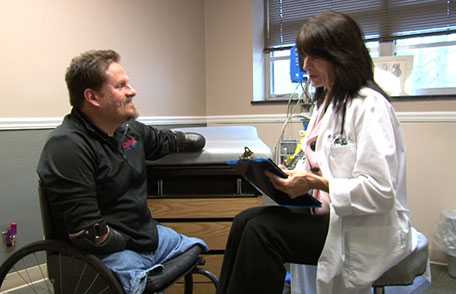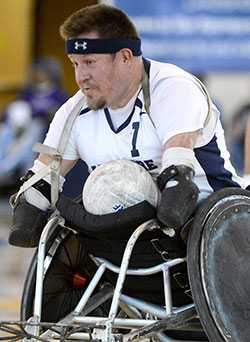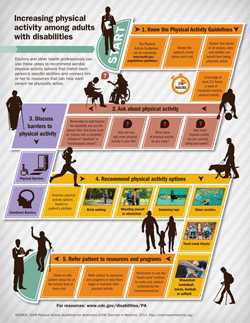Physical Activity is for Everybody
 Everybody needs physical activity for good health. However, nearly half of adults with disabilities, who are able to participate in physical activity, don’t get any. Learn how people with disabilities can include physical activity in their lives.
Everybody needs physical activity for good health. However, nearly half of adults with disabilities, who are able to participate in physical activity, don’t get any. Learn how people with disabilities can include physical activity in their lives.
Physical activity plays an important role in maintaining health, well-being, and quality of life. According to the 2008 Physical Activity Guidelines for Americans, physical activity can help control weight, improve mental health, and lower the risk for early death, heart disease, type 2 diabetes, and some cancers. For people with disabilities, it also can help improve the ability to do daily living activities and increase independence.
All adults need regular physical activity and should get at least 2-and-1/2 hours a week of aerobic physical activity at a moderate-intensity level. Most adults with disabilities are able to participate in physical activity and should try to meet the above guidelines. When adults with disabilities are not able to meet the guidelines, they should engage in regular physical activity according to their abilities and should avoid inactivity; some activity is better than none. Learn how people with disabilities are embracing physical activity and improving their health and well-being.

“I have received a ton of benefits from working out. I have more energy. I’ve lowered my blood pressure, but probably most important to me is that I’ve increased my independence.”

“When you are out of shape as a wheelchair user, everything is harder.”
London’s Story
London had a spinal cord injury in 2008 that significantly affects his mobility. While he was lying in bed after his injury, he thought “this can’t be it”; he wanted more for his life, especially more independence. After talking with his doctor, who recommended physical activity, London started visiting Lakeshore Foundation, a fitness and recreation center for individuals with disabilities and chronic health conditions. He now exercises 6 days a week; he likes to use the bike, treadmill, and seated elliptical, as well as swim.
“I have received a ton of benefits from working out,” he says, “I have more energy. I’ve lowered my blood pressure, but probably most important to me is that I’ve increased my independence.” When asked what advice he has for other people with disabilities, London says, “make a conscious effort to stay positive and keep a good attitude. Advocate for yourself. Find out what your options are to be active and do it!”
Rashad’s Story
Rashad’s dream, since he was a little kid, was to play college basketball. Currently, he is on the University of Alabama wheelchair basketball team. Rashad has FSP, or Familial Spastic Paraparesis; it is a genetic condition that gets progressively worse as a person ages. Although Rashad is still able to stand up if he needs to, he uses a wheelchair. “When you are out of shape as a wheelchair user, everything is harder,” he says. That and his love for basketball are what keep him motivated to be physically active every day. Rashad has also improved his eating habits, and this healthy behavior combined with exercise has resulted in a forty pound weight loss.
“Now, I am able to get up and down the court faster, transfer more easily, and just overall feel better,” he says. It didn’t happen overnight, but he was able to get where he wanted to be. His advice – “You have to be committed. Find something you enjoy doing, which for me was wheelchair basketball, and stick with it. In the end, you will see that it is definitely worth it.”
CDC would like to thank London, Rashad, and our partner, the National Center on Health, Physical Activity, and Disability (NCHPAD) located within Lakeshore, for sharing their stories with us.
CDC’s Disability and Health Branch supports and provides funding to NCHPAD to improve the health, wellness, and quality of life of people with disabilities. NCHPAD seeks to help people with disability and other chronic health conditions achieve health benefits through increased participation in all types of physical and social activities, including fitness and aquatic activities, recreational and sports programs, adaptive equipment usage, and more.
Visit the National Center on Health, Physical Activity and Disability (NCHPAD) website.
Find Your Own Path to Physical Activity
If you or somebody in your family has a disability and wants to add more routine physical activity, here are steps you can follow:
- Visit your doctor.
- Talk to your doctor about how much and what kind of physical activity is right for you.
- Discuss your barriers to physical activity.
- Ask your doctor to put you in contact with resources and programs to help you begin being active or maintain your physical activity level.
- Be active your way.
- Decide how much physical activity is right for you and your fitness level.
- Decide what kind of physical activity you enjoy and add physical activity to your everyday life. General gardening, doing active chores around the house, wheeling yourself in your wheelchair, walking briskly, dancing, swimming, and playing wheelchair basketball, tennis or soccer are all examples of physical activities that improve health and well-being.
- Start slowly.
Start slowly based on your abilities and fitness level. For example, be active for at least 10 minutes at a time, and then slowly increase activity over several weeks if necessary. Avoid being inactive; some activity is better than none!
- Have fun with family and friends.
It’s easier to stay active when you have the support of your family and friends. Invite your loved ones to have fun with you. For example, together you might play outside with a ball, dance, or walk or wheel around the neighborhood.
What CDC and Our National Programs are Doing
CDC’s Disability and Health Branch supports and provides funding for two National Centers on Disability that focus on improving the quality of life for people living with disabilities, including their physical activity:
- National Center on Health, Physical Activity, and Disability (NCHPAD)
- Special Olympics Healthy Athletes Program
The Branch also supports 18 state-based programs to promote equity in health, prevent chronic diseases, and increase the quality of life for people with disabilities. Learn more about the State’s Disability and Health Programs.
Glossary
Aerobic physical activity is when the body’s large muscles move in a rhythmic manner for a sustained period of time. Aerobic activity, also called endurance or cardio activity, improves heart and lung fitness. Examples include walking, running, swimming, and bicycling.
Chronic diseases are illnesses or medical conditions that go on for a long time and often don’t go away completely. People’s symptoms may be better or worse over time, and they may use treatments to control symptoms and feel better. Examples of chronic diseases include diabetes, heart disease, HIV/AIDS, arthritis, and asthma.
Equity in health is the result of efforts taken to ensure that all people have full and equal access to opportunities that enable them to lead healthy lives.
More Information
More Information
Disability Resources at CDC
Being healthy means the same thing for everybody—staying well so we can lead full, active lives. Having the tools and information to make healthy choices and knowing how to prevent illness is key to being well, with or without a disability. Visit these resources to learn more:
- Page last reviewed: May 23, 2016
- Page last updated: May 23, 2016
- Content source:
- National Center on Birth Defects and Developmental Disabilities
- Page maintained by: Office of the Associate Director for Communication, Digital Media Branch, Division of Public Affairs




 ShareCompartir
ShareCompartir